
B-hNKC/hKIR mice
C57BL/6-Klrb1atm1Bcgen Clec2htm1Bcgen Klrb1tm1(KLRB1)Bcgen Klrb1ctm1Bcgen Klrb1btm1Bcgen Clec2itm1Bcgen Clec2gtm1Bcgen Clec2ftm1Bcgen Klrb1ftm1Bcgen Clec2etm1Bcgen Clec2dtm1(CLEC2D)Bcgen Cd69tm1(CD69)Bcgen NKCtm1(KLRF1)Bcgen NKCtm1(CLEC2B)Bcgen NKCtm1(KLRF2)Bcgen NKCtm1(CLEC2A)Bcgen Clec2mtm1Bcgen Clec12atm1(CLEC12A)Bcgen Clec1btm1(CLEC1B)Bcgen Clec12btm1(CLEC12B)Bcgen Clec9atm1(CLEC9A)Bcgen Clec1atm1(CLEC1A)Bcgen Clec7atm1(CLEC7A)Bcgen Olr1tm1(OLR1)Bcgen Tmem52btm1(TMEM52B)Bcgen Gabarapl1tm1(GABARAPL1)Bcgen Klre1tm1Bcgen Cd94tm1(CD94)Bcgen Klrk1tm1(KLRK1)Bcgen NKCtm1(KLRC4)Bcgen Klrc3tm1(KLRC3)Bcgen Klrc2tm1(KLRC2)Bcgen Klrc1tm1(KLRC1)BcgenIgs2tm1(KIR3DL3/KIR2DL3/KIR2DL1/KIR2DL4/KIR3DL1/KIR2DS4/KIR3DL2)Bcgen/Bcgen • 114044

B-hNKC/hKIR mice
C57BL/6-Klrb1atm1Bcgen Clec2htm1Bcgen Klrb1tm1(KLRB1)Bcgen Klrb1ctm1Bcgen Klrb1btm1Bcgen Clec2itm1Bcgen Clec2gtm1Bcgen Clec2ftm1Bcgen Klrb1ftm1Bcgen Clec2etm1Bcgen Clec2dtm1(CLEC2D)Bcgen Cd69tm1(CD69)Bcgen NKCtm1(KLRF1)Bcgen NKCtm1(CLEC2B)Bcgen NKCtm1(KLRF2)Bcgen NKCtm1(CLEC2A)Bcgen Clec2mtm1Bcgen Clec12atm1(CLEC12A)Bcgen Clec1btm1(CLEC1B)Bcgen Clec12btm1(CLEC12B)Bcgen Clec9atm1(CLEC9A)Bcgen Clec1atm1(CLEC1A)Bcgen Clec7atm1(CLEC7A)Bcgen Olr1tm1(OLR1)Bcgen Tmem52btm1(TMEM52B)Bcgen Gabarapl1tm1(GABARAPL1)Bcgen Klre1tm1Bcgen Cd94tm1(CD94)Bcgen Klrk1tm1(KLRK1)Bcgen NKCtm1(KLRC4)Bcgen Klrc3tm1(KLRC3)Bcgen Klrc2tm1(KLRC2)Bcgen Klrc1tm1(KLRC1)BcgenIgs2tm1(KIR3DL3/KIR2DL3/KIR2DL1/KIR2DL4/KIR3DL1/KIR2DS4/KIR3DL2)Bcgen/Bcgen • 114044

B-hNKC/hKIR mice
| Product name | B-hNKC/hKIR mice |
|---|---|
| Catalog number | 114044 |
| Strain name | C57BL/6-Klrb1atm1Bcgen Clec2htm1Bcgen Klrb1tm1(KLRB1)Bcgen Klrb1ctm1Bcgen Klrb1btm1Bcgen Clec2itm1Bcgen Clec2gtm1Bcgen Clec2ftm1Bcgen Klrb1ftm1Bcgen Clec2etm1Bcgen Clec2dtm1(CLEC2D)Bcgen Cd69tm1(CD69)Bcgen NKCtm1(KLRF1)Bcgen NKCtm1(CLEC2B)Bcgen NKCtm1(KLRF2)Bcgen NKCtm1(CLEC2A)Bcgen Clec2mtm1Bcgen Clec12atm1(CLEC12A)Bcgen Clec1btm1(CLEC1B)Bcgen Clec12btm1(CLEC12B)Bcgen Clec9atm1(CLEC9A)Bcgen Clec1atm1(CLEC1A)Bcgen Clec7atm1(CLEC7A)Bcgen Olr1tm1(OLR1)Bcgen Tmem52btm1(TMEM52B)Bcgen Gabarapl1tm1(GABARAPL1)Bcgen Klre1tm1Bcgen Cd94tm1(CD94)Bcgen Klrk1tm1(KLRK1)Bcgen NKCtm1(KLRC4)Bcgen Klrc3tm1(KLRC3)Bcgen Klrc2tm1(KLRC2)Bcgen Klrc1tm1(KLRC1)BcgenIgs2tm1(KIR3DL3/KIR2DL3/KIR2DL1/KIR2DL4/KIR3DL1/KIR2DS4/KIR3DL2)Bcgen/Bcgen |
| Strain background | C57BL/6 |
| NCBI gene ID | 3820,29121,969,51348,9976,100431172,387836,160364,51266,387837,283420,51267,64581,4973,120939,23710,3824,22914,8302,3823,3822,3821,115653,3804,3802,3805,3811,3809,3812 (Human) |
| Chromosome | 6, 11 |
| Aliases | CD161, CLEC5B, NKR, NKR-P1, NKR-P1A, NKRP1A, hNKR-P1A; CLAX, LLT1, OCIL; AIM, BL-AC/P26, CLEC2C, EA1, GP32/28, MLR-3; CLEC5C, NKp80; AICL, CLECSF2, HP10085, IFNRG1; NKp65; INPE5792, KACL, PILAR, UNQ5792; CD371, CLL-1, CLL1, DCAL-2, MICL; 1810061I13Rik, CLEC2, CLEC2B, PRO1384, QDED721; UNQ5782; CD370, DNGR-1, DNGR1, UNQ9341; CLEC-1, CLEC1; BGR, CANDF4, CD369, CLECSF12, DECTIN1, SCARE2; CLEC8A, LOX1, LOXIN, SCARE1, SLOX1; C12orf59; APG8-LIKE, APG8L, ATG8, ATG8B, ATG8L, GEC1; CD94; CD314, D12S2489E, KLR, NKG2-D, NKG2D; NKG2-F, NKG2F; NKG2-E, NKG2E; CD159c, NKG2-C, NKG2C; CD159A, NKG2, NKG2A; CD158Z, KIR3DL7, KIR44, KIRC1; CD158B2, CD158b, GL183, KIR-023GB, KIR-K7b, KIR-K7c, KIR2DL, KIR2DS5, KIRCL23, NKAT, NKAT2, NKAT2A, NKAT2B, p58; CD158A, KIR-K64, KIR221, KIR2DL3, NKAT, NKAT-1, NKAT1, p58.1; CD158D, G9P, KIR-103AS, KIR-2DL4, KIR103, KIR103AS; CD158E1, KIR/S1, NKAT-3, NKAT3, NKB1, NKB1B, KIR3DL1; CD158I, KIR-2DS4, KIR1D, KIR412, KKA3, NKAT-8, NKAT8; 3DL2, CD158K, KIR-3DL2, NKAT-4, NKAT4, NKAT4B, p140 |
在此页面上
- Targeting strategy
- Phenotypic analysis
- Physiological data
发表文章
- February 16, 2024Oncoimmunology
- May 13, 2022
The establishment and application of CD3E humanized mice in immunotherapy
Experimental Animals
 Targeting strategy
Targeting strategy
Gene targeting strategy for B-hNKC/hKIR mice.
The mouse NKC cluster is replaced by human NKC cluster counterparts in B-hNKC/hKIR mice. The human NKC expression is driven by endogenous human NKC promoter, 5’UTR and 3’UTR. While mouse NKC gene transcription and translation will be disrupted. The mouse NKC cluster contain Klrb1a, Clec2h, Klrb1, Klrb1c, Klrb1b, Clec2i, Clec2g, Clec2f, Klrb1f, Clec2e, Clec2d, Cd69, Clec2m, Clec12a, Clec1b, Clec12b, Clec9a, Clec1a, Clec7a, Olr1, Tmem52b, Gabarapl1, Klre1, Klrd1, Klrk1, Klrc3, Klrc2 and Klrc1. The human NKC cluster contain KLRB1, CLEC2D, CD69, KLRF1, CLEC2B, KLRF2, CLEC2A, CLEC12A, CLEC1B, CLEC12B, CLEC9A, CLEC1A, CLEC7A, OLR1, TMEM52B, GABARAPL1, KLRD1, KLRK1, KLRC4, KLRC3, KLRC2 and KLRC1.
Bacterial artificial chromosome (BAC) clones for the human KIR3DL3, KIR2DL3, KIR2DL1, KIR2DL4, KIR3DL1, KIR2DS4 and KIR3DL2 genes, including the promoter, 5’UTR and 3’UTR are inserted into mouse Hipp11 (H11) locus in B-hNKC/hKIR mice.
 Protein expression analysis in spleen
Protein expression analysis in spleen

Strain specific NKG2A and NKG2C expression analysis in wild-type C57BL/6JNifdc mice and humanized B-hNKC/hKIR mice by flow cytometry. Splenocytes were collected from wild-type C57BL/6JNifdc mice (+/+) and B-hNKC/hKIR mice (H/+, H/H) (male, 10-week-old, n=1). Protein expression was analyzed with anti-mouse NKG2A antibody (Biolegend, 142810), anti-human NKG2A antibody (monalizumab) and anti-human NKG2C antibody (Biolegend, 375004) by flow cytometry. Mouse NKG2A was detectable in wild-type C57BL/6JNifdc mice and B-hNKC/hKIR mice. Human NKG2A and NKG2C were exclusively detectable in B-hNKC/hKIR mice, but not in wild-type C57BL/6JNifdc mice.

Strain specific NKG2D expression analysis in wild-type C57BL/6JNifdc mice and humanized B-hNKC/hKIR mice by flow cytometry. Splenocytes were collected from wild-type C57BL/6JNifdc mice (+/+) and B-hNKC/hKIR mice (H/+, H/H) (male, 10-week-old, n=1). Protein expression was analyzed with anti-mouse NKG2D antibody (eBioscience™, 25-5882-82) and anti-human NKG2D antibody (Biolegend, 320808) by flow cytometry. Mouse NKG2D was detectable in wild-type C57BL/6JNifdc mice and B-hNKC/hKIR mice. Human NKG2D was exclusively detectable in B-hNKC/hKIR mice, but not in wild-type C57BL/6JNifdc mice.
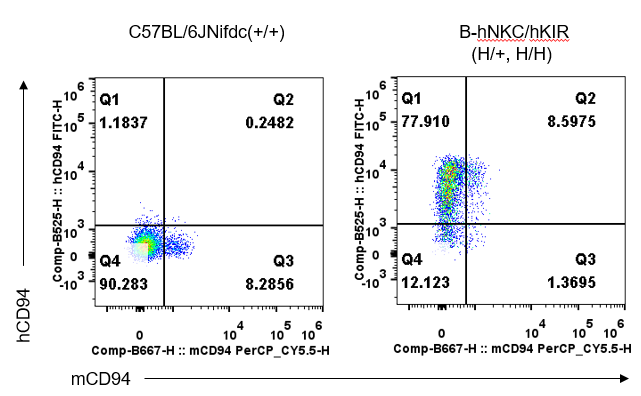
Strain specific CD94 expression analysis in wild-type C57BL/6JNifdc mice and humanized B-hNKC/hKIR mice by flow cytometry. Splenocytes were collected from wild-type C57BL/6JNifdc mice (+/+) and B-hNKC/hKIR mice (H/+, H/H) (male, 10-week-old, n=1). Protein expression was analyzed with anti-mouse CD94 antibody (Biolegend, 105513) and anti-human CD94 antibody (Biolegend, 305504) by flow cytometry. Mouse CD94 was detectable in wild-type C57BL/6JNifdc mice and B-hNKC/hKIR mice. Human CD94 was exclusively detectable in B-hNKC/hKIR mice, but not in wild-type C57BL/6JNifdc mice.
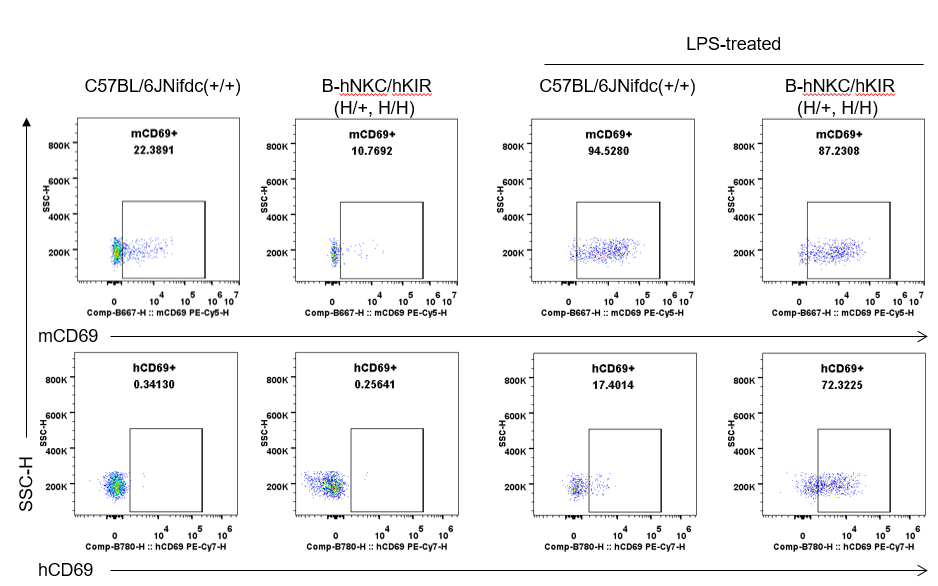
Strain specific CD69 expression analysis in wild-type C57BL/6JNifdc mice and humanized B-hNKC/hKIR mice by flow cytometry. Splenocytes were collected from wild-type C57BL/6JNifdc mice (+/+) and B-hNKC/hKIR mice (H/+, H/H) stimulated with LPS (20 μg, i.p.) in vivo for 2 hrs (male, 9-week-old, n=2). Protein expression was analyzed with anti-mouse CD69 antibody (Biolegend, 104509) and anti-human CD69 antibody (Biolegend, 310912) by flow cytometry. Mouse CD69 was detectable in wild-type C57BL/6JNifdc mice and B-hNKC/hKIR mice. Human CD69 was exclusively detectable in B-hNKC/hKIR mice, but not in wild-type C57BL/6JNifdc mice. CD69 upregulation after LPS stimulation can also be found in other immune cell types (data not shown).
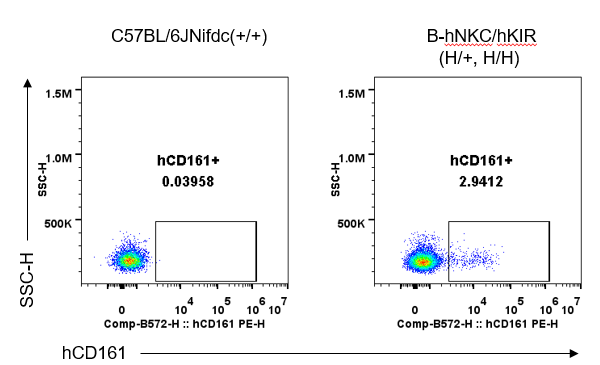
Strain specific CD161 expression analysis in wild-type C57BL/6JNifdc mice and humanized B-hNKC/hKIR mice by flow cytometry. Splenocytes were collected from wild-type C57BL/6JNifdc mice (+/+) and B-hNKC/hKIR mice (H/+, H/H) (male, 11-week-old, n=1). Protein expression was analyzed with anti-human CD161 antibody (Biolegend, 339904) by flow cytometry. Human CD161 was exclusively detectable in B-hNKC/hKIR mice, but not in wild-type C57BL/6JNifdc mice.

Strain specific CLEC12A expression analysis in wild-type C57BL/6JNifdc mice and humanized B-hNKC/hKIR mice by flow cytometry. Splenocytes were collected from wild-type C57BL/6JNifdc mice (+/+) and B-hNKC/hKIR mice (H/+, H/H) (male, 11-week-old, n=1). Protein expression was analyzed with anti-mouse CLEC12A antibody (Biolegend, 143405) and anti-human CLEC12A antibody (Biolegend, 353604) by flow cytometry. Mouse CLEC12A was detectable in wild-type C57BL/6JNifdc mice and B-hNKC/hKIR mice. Human CLEC12A was exclusively detectable in B-hNKC/hKIR mice, but not in wild-type C57BL/6JNifdc mice.
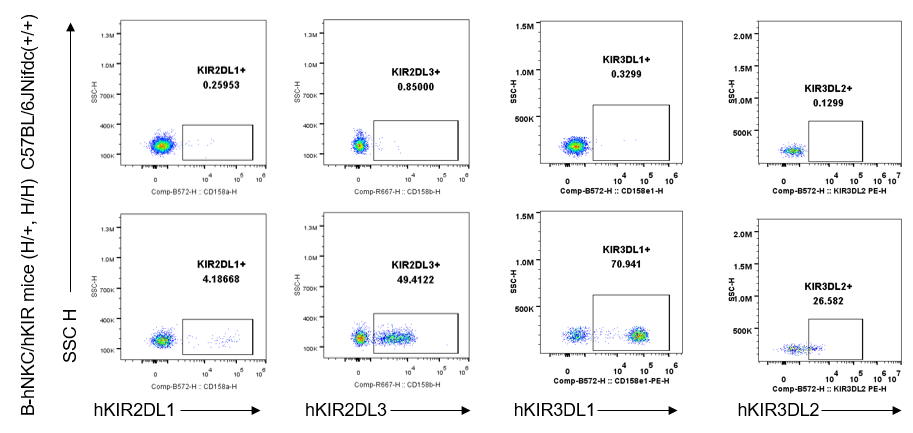
Strain specific KIR-related protein expression analysis in wild-type C57BL/6JNifdc mice and humanized B-hNKC/hKIR mice by flow cytometry. Splenocytes were collected from wild-type C57BL/6JNifdc mice (+/+) and B-hNKC/hKIR mice (H/+, H/H) (male, 11-week-old, n=1). Protein expression was analyzed with anti-human KIR2DL1 antibody (Biolegend, 374904), anti-human KIR2DL3 antibody (Biolegend, 312612), anti-human KIR3DL1 antibody (Biolegend, 312708) and anti-human KIR3DL2 antibody (R&D System, FAB2878P-100) by flow cytometry, respectively. Human KIR2DL1, KIR2DL3, KIR3DL1 and KIR3DL2 were exclusively detectable in B-hNKC/hKIR mice (H/+,H/H) (male, 11-week-old, n=1), but not in wild-type C57BL/6JNifdc mice.
 Protein expression analysis in Bone marrow
Protein expression analysis in Bone marrow
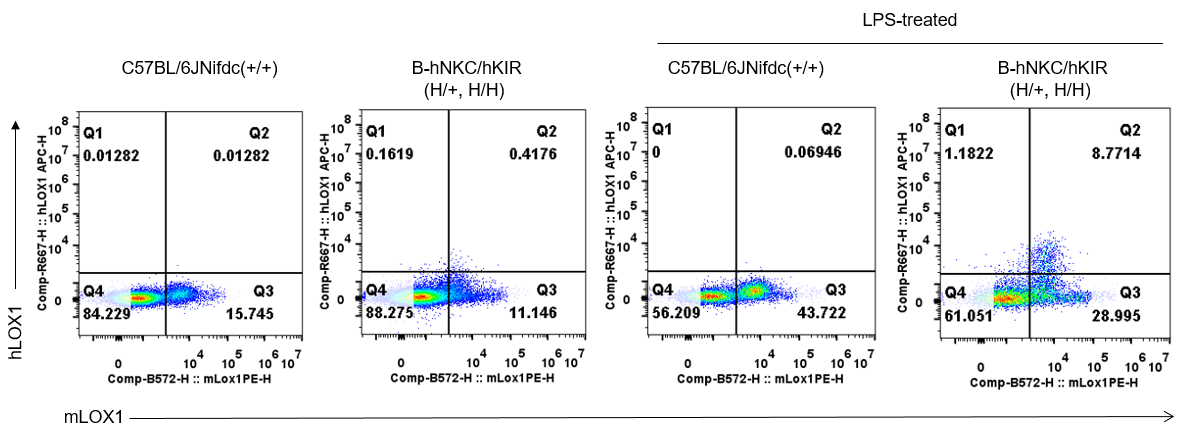
Strain specific LOX1 expression analysis in wild-type C57BL/6JNifdc mice and humanized B-hNKC/hKIR mice by flow cytometry. Bone marrow were collected from wild-type C57BL/6JNifdc mice (+/+) and B-hNKC/hKIR mice (H/+, H/H) stimulated with LPS(20 μg, i.p.) in vivo for 2 hrs (male, 11-week-old, n=2). Protein expression was analyzed with anti-mouse LOX1 antibody (R&D System, FAB1564P) and anti-human LOX1 antibody (Biolegend, 358606) by flow cytometry. Mouse LOX1 was detectable in wild-type C57BL/6JNifdc mice and B-hNKC/hKIR mice. Human LOX1 was exclusively detectable in B-hNKC/hKIR mice, but not in wild-type C57BL/6JNifdc mice.
 mRNA expression analysis in spleen
mRNA expression analysis in spleen

Species specific analysis of CLEC2D gene expression in wild-type C57BL/6JNifdc mice and humanized B-hNKC/hKIR mice by RT-qPCR. Splenocytes were collected from wild-type C57BL/6JNifdc mice (+/+) and B-hNKC/hKIR mice (H/+, H/H) (male, 11-week-old, n=6) stimulated with LPS(20 μg, i.p.) in vivo for 2 hrs (male, 11-week-old, n=6). The mRNA expression of mouse CLEC2D was detectable in wild-type C57BL/6JNifdc mice and B-hNKC/hKIR mice. The mRNA expression of human CLEC2D can be detected only in humanized B-hNKC/hKIR mice. CLEC2D can be upregulated after LPS stimulation. Values are expressed as mean ± SEM. Significance was determined by unpaired t-test. *P < 0.05, **P < 0.01, ***P < 0.001.
 mRNA expression analysis in humanized B-hNKC/hKIR mice
mRNA expression analysis in humanized B-hNKC/hKIR mice
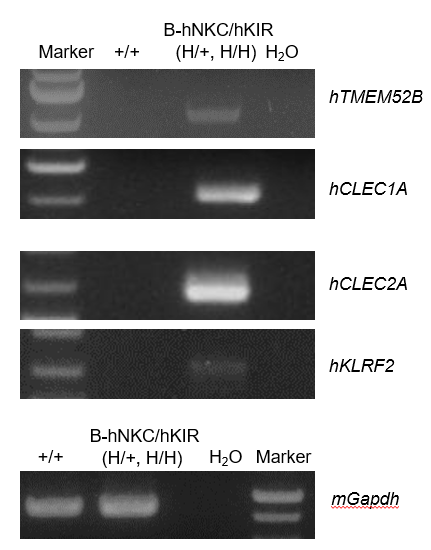
Species specific analysis of TMEM52B and CLEC1A gene expression in wild-type C57BL/6JNifdc mice and humanized B-hNKC/hKIR mice by RT-PCR. Splenocytes were collected from wild-type C57BL/6JNifdc mice (+/+) and homozygous B-hNKC/hKIR mice (H/+, H/H). Human TMEM52B and human CLEC1A mRNA were detectable only in B-hNKC/hKIR mice, but not in wild-type C57BL/6JNifdc mice.
Species specific analysis of KLRF2 and CLEC2A gene expression in wild-type C57BL/6JNifdc mice and humanized B-hNKC/hKIR mice by RT-PCR. Bone marrow were collected from wild-type C57BL/6JNifdc mice (+/+) and homozygous B-hNKC/hKIR mice (H/+, H/H). Human KLRF2 and human CLEC2A mRNA were detectable only in B-hNKC/hKIR mice, but not in wild-type C57BL/6JNifdc mice.
 Frequency of leukocyte subpopulations in spleen
Frequency of leukocyte subpopulations in spleen
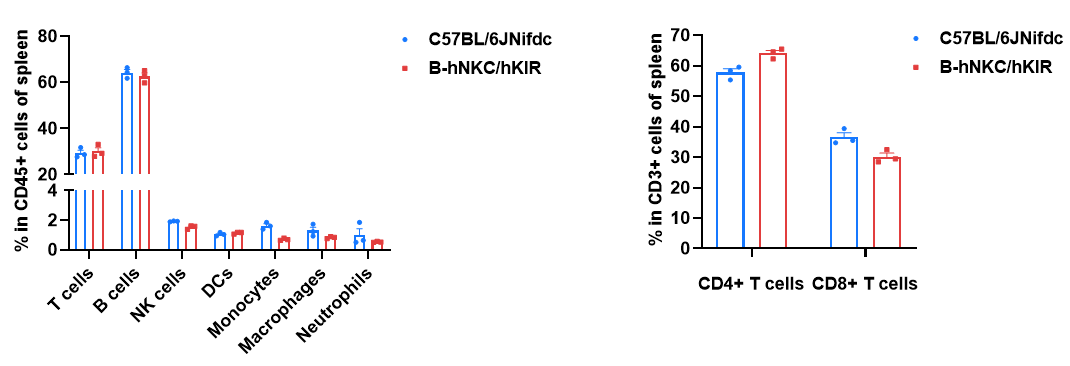
Frequency of leukocyte subpopulations in spleen by flow cytometry. Splenocytes were isolated from wild-type C57BL/6JNifdc mice and B-hNKC/hKIR mice (H/+, H/H) (male, 10-week-old, n=3). A. Flow cytometry analysis of the splenocytes was performed to assess the frequency of leukocyte subpopulations. B. Frequency of T cell subpopulations. Frequencies of T cells, B cells, dendritic cells, monocytes, macrophages and neutrophils in B-hNKC/hKIR mice were similar to those in C57BL/6JNifdc mice. Compared with C57BL/6JNifdc mice, the proportion of CD4+ T cells and CD8+ T cells changed in B-hNKC/hKIR mice, the proportion of CD8+ T cells in B-hNKC/hKIR mice decreased and CD4+ T cells in B-hNKC/hKIR mice increased.
 Frequency of NK populations in Spleen, Blood, Bone Marrow and Lung
Frequency of NK populations in Spleen, Blood, Bone Marrow and Lung
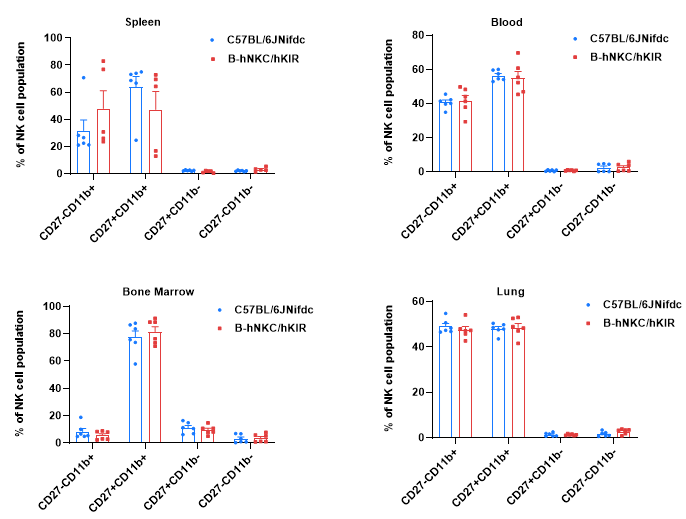
Frequency of NK populations in Spleen, Blood, Bone Marrow and Lung by flow cytometry. Splenocytes, blood, bone marrow and lung were collected from wild-type C57BL/6JNifdc mice (+/+) and homozygous B-hNKC/hKIR mice (H/+, H/H) (male, 9-week-old, n=3; female, 9-week-old, n=3). No apparent difference was found between wild-type C57BL/6JNifdc mice (+/+) and B-hNKC/hKIR mice. Splenocytes from B-hNKC/hKIR mice (male, 9-week-old, n=3; female, 9-week-old, n=2).